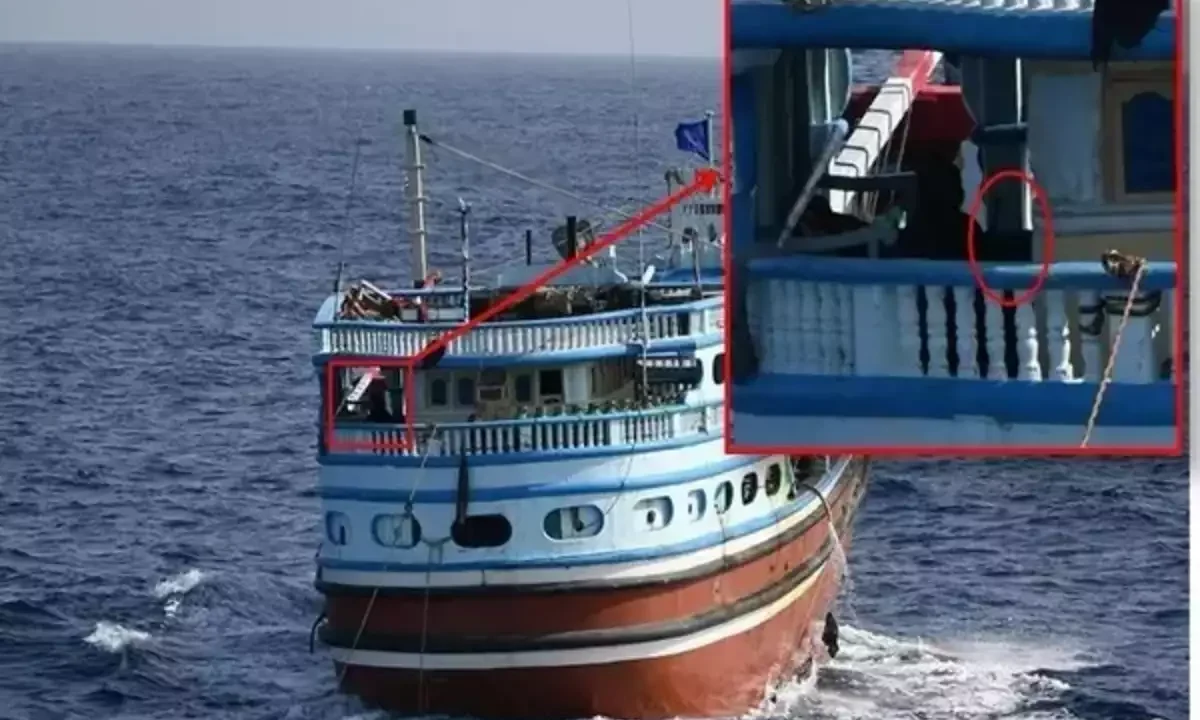
The Indian Navy rescued 23 Pakistanis in the Indian Ocean: Iranian ship rescued from Somali pirates; Operation lasted for 12 hours.
The Indian Navy shared pictures on social media platforms and provided information about the operation that lasted for 12 hours.
On Friday (March 29), the Indian Navy conducted an operation against Somali sea pirates and rescued 23 Pakistanis. The Navy informed on social media platform X that on Friday evening, their team received information about the hijacking of an Iranian ship ‘Al-Kambar’ near the Gulf of Aden in the Indian Ocean.
Upon receiving the hijack alert, nine Somali sea pirates had seized this ship, which was approximately 166 kilometers southwest of Socotra Island in Yemen. The Indian Navy immediately deployed its warship INS Sumedha to intercept the Iranian ship and prevent the hijacking.

The Indian Navy shared pictures on social media platforms showing a pirate on the ship within the red circle.
Two warships of the Navy conducted a 12-hour operation, leading to the surrender of 9 pirates.
Subsequently, with the assistance of the second warship INS Trishul, the Navy rescued the ship from the pirates. The Navy’s team conducted the operation for 12 hours to compel the pirates to surrender. Currently, the team is inspecting the ship, and then it will be taken to a safe location.
Since the start of the Israel-Hamas conflict last October, incidents of hijacking by Somali pirates in the Arabian Sea have been increasing. In response, the Indian Navy has increased the deployment of warships in the Arabian Sea.
The previous four hijacking incidents…
March 15: Indian Navy rescued a hijacked ship of Malta within 40 hours.

Three months ago, on December 14, the Indian Navy completed the operation to rescue the hijacked ship MV RUEEN in the Gulf of Aden on March 15. The operation was conducted approximately 2800 kilometers away from India’s maritime border. The Navy reported that following their action, 35 sea pirates surrendered, and 17 crew members were safely evacuated.
The MV RUEEN crew was held hostage by pirates for more than 110 days. This rescue operation lasted for 40 hours. To accomplish this, the warship INS Subhadra, drones capable of flying at higher altitudes, and P8I patrol aircraft were utilized. The hijacked ship MV RUEEN is now completely under the control of the Indian Navy.
January 29: Safely evacuated 17 people, including the crew, from an Iranian ship.

On January 29, the Indian Navy warship INS Sumitra stationed off the coast of Somalia rescued an Iranian ship from maritime pirates. The Navy reported that all 17 individuals aboard the ship, including crew members, are safe.
Commander Vivek Madhwal, the Navy spokesperson, stated that INS Sumitra received information about the Iranian-flagged ship being hijacked by pirates in the Gulf of Aden. The security personnel onboard immediately took action and rescued the Iranian ship and its crew members from the pirates.
January 4: Rescued 15 Indian nationals aboard a Liberian ship.

The footage shows an Indian Navy boat approaching the hijacked ship.
On January 4, near the coast of Somalia in the Arabian Sea, maritime pirates hijacked the Liberian-flagged ship MV Lila Norfok. The Indian Navy reported that the ship had sent a message on the Maritime Trade Operations (UKMTO) portal.
Subsequently, INS Chennai was deployed to rescue them. Indian Navy Marcos Commandos rescued 21 individuals aboard the hijacked ship, including 15 Indians. According to Marine Traffic, the ship was sailing from Porto do Acu, Brazil, to Khalifa Bin Salman Port, Bahrain.
Maritime piracy has increased in Somalia since the 1990s.

Pirates take ransom in exchange for releasing hijacked ships.
Somalia is a country where a large number of fish are found in its seas. Until 1990, its economy relied heavily on fishing. At that time, there was no fear of maritime pirates in these waters. Most people were involved in the fishing trade. Then civil war broke out, and there was no government or navy left. Foreign companies took advantage of this situation.
Somali people used to catch fish in small boats. But then large trawlers from foreign companies started appearing, taking away the livelihood of the locals. Frustrated by this, people in Somalia turned to piracy after 1990. A major shipping route of merchant vessels passed near the Somali coast.
Those who were once fishermen turned into pirates targeted these ships. Instead of leaving the ships, they began to demand ransom. By 2005, this business had grown so much that a pirate stock exchange was established. This meant that people could invest in funding pirate campaigns. In return, they received a significant share of the ransom money.




















